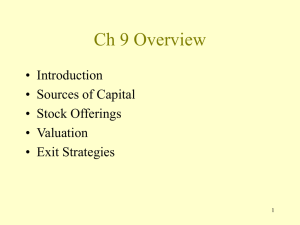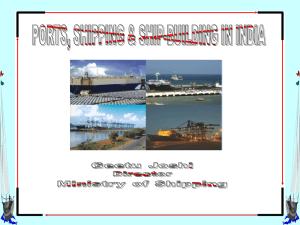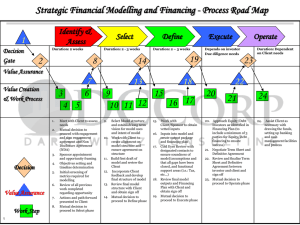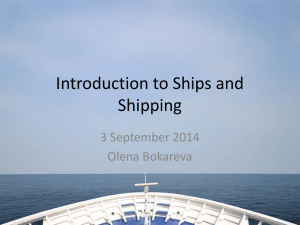Project Management & Capital Acquisition: A Presentation
advertisement
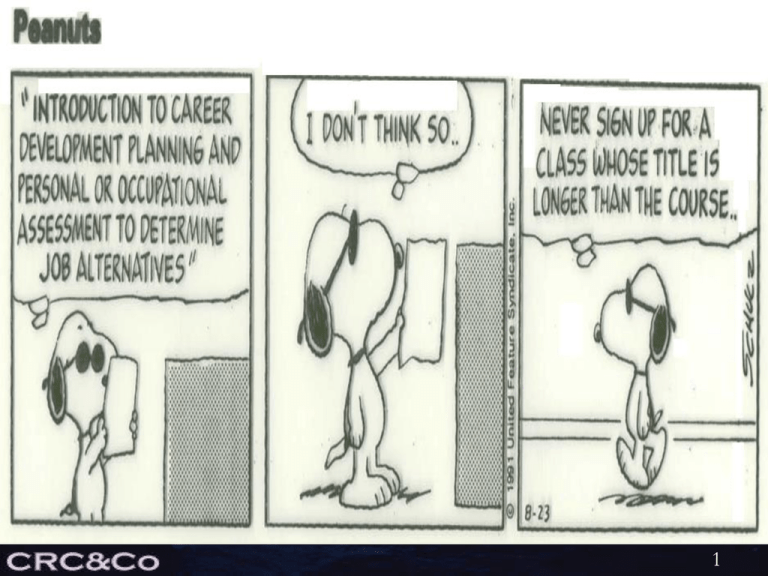
1 PROJECT MANAGEMENT WITH REFERENCE TO THE CAPITAL ACQUISITION PROCESS Copyright C. R. Cushing 2011 2 Charles R. Cushing, Ph.D., P.E. 30 Vesey Street, 7th Floor New York, NY 10007 Tel. (212) 964-1180 Fax (212) 285-1334 E-mail ccushing@crcco.com 3 4 Typical Ship Prices Ship Type $, Millions Container Ship, 12,600 TEU 165 Tanker, Capesize 95 Tanker, VLCC 115 Container – Reefer, 7450 TEU / 3400 Reefer 143 Container Ship 70 Bulk Carrier, 92,500 DWT 70 Bulk Carrier, 34,000 DWT 37 Tanker, Chemical 4,300 DWT 20 Ore Carrier, VLOC 350,000 DWT 135 Cruise Ship, 6,400 Passenger 1,240 Log Carrier, 35,000 DWT 30 Multi-Purpose Cargo, 5,670 DWT 14 Bulk Carrier, 92,500 DWT 70 5 World Population of Merchant Ships, December 2010 Commercial Ships: No.(%) General Cargo 18,178(23.4) GRT x 1,000(%) 63,525(6.8) Container Ships 4,869(6.3) 158,112(16.9) Ro Ro Ships 1,556(2.0) 41,704(4.5) Bulk Carriers 8,920(11.5) 292,906(31.4) Oil and Chem Tankers 12,014(15.4) 260,735(27.9) Gas Tankers 1,552(2.0) 48,159(5.2) Passenger Vessels 6,382(8.2) 34,100(3.7) Offshore Vessels 6,283(8.1) 19,248(2.1) Tugs 3,757(17.7) 3,879(0.4) Other 4,257 (5.4) 10567(1.1) 77,768(100) 932,935(100) Total 6 Ships on Order (December 2009) No. 9,226* GRT 300,500,000 CGT 152,000,000 * Of which 7,282 are cargo vessels Source: Lloyds Fairplay Dec. 2009 7 Process Applies To: Ships Ports Cranes Factories Refineries Other Capital Projects 8 Capacity Acqusition Alternatives New Construction Conversion Purchase Second-hand Vessel Bareboat Charter Time Charter Contract of Affreightment Freight Service Agreement Consecutive Voyage Charter Spot Charter Vessel Pooling Slot Charter 9 History of Project Management Dates back to early civilization Creative architects and engineers 10 Capital Projects Egyptian Pyramids 11 Capital Projects Great Wall of China 12 History of Project Management Imhotep – Pyramids (2630 BC) Qin Shi Huang – Great Wall (221 BC) Vitrvius – Roman Aqueducts (100 BC) Christopher Wren – St. Paul’s Cathedral (1632 – 1723 AD) Thomas Telford – Bridges & Canals (1754 – 1834 AD) Isambard K. Brunel – Great Western Railway (1806 – 1859) 13 Recent Developments in Project Management Fredrick Wilson Taylor – Pioneer in theories of scientific management (WBS) Henry Gantt – Father of planning and control techniques – (Gantt Chart) Dupont / Remington Rand – Critical Path Method (CPM) Booz – Allen & Hamilton – Program Evaluation and Review Technique (PERT) 14 Capital Projects Ships Ports 15 Project Management Planning Organizing Managing Resources to Achieve Specific Goals 16 Project Temporary Endeavor Defined Beginning Defined End Unique Goals and Objectives 17 Traditional Project Management Initiation Planning Design Execution Commercial Production Completion 18 19 20 Project Management Process Traditional PM Critical Chain PM Extreme PM Agile PM Event Chain PM Event Chain Methodology Prince2 (Prompt + Prince) Process-Based Management 21 The Process Consists Of: Planning Design Commercial Production 22 “Now here’s an advanced organism. You’ll note the nucleus and cytoplasm development, along with what appears to be the first draft of a strategic plan.” 23 24 25 26 27 Origins of Strategic Planning 473 BC 1645 1800 1850’s 1860’s 1900 Sun Tzu’s The Art of War Miayamoto Mushashi’s A Book of Rings Napoleon Industrial Revolution Policies and Procedures Work Norms and Standings 28 Origins of Strategic Planning (Cont’d.) 1916 1920’s 1930’s 1940’s 1950’s 1970’s-80’s 1990’s WWI Battle Strategy Financial Planning and Control Management by Objectives WWII O.S.S./C.I.A. Strategic Planning Global Spread of Strategic Planning Strategic Management 29 Development of Planning 30 Factors that Make Strategic Planning Essential in the Marine Industry Cyclical market conditions Fluctuating currency exchange rates Uncertainty in fuel costs Uncertainty in interest rates Emergence of trading partners and trading alliances Over tonnaging due (partially) to overly generous subsidies Regulatory and governmental restraints Fast paced technology (leading to premature technological obsolescence) More rapid response by Safety and Environmental Regulatory Bodies to disasters 31 Benefits of Using this Process Opportunity to optimize vessel characteristics Improved delivery time Better use of lead time Better financing and currency terms Better guarantees Control of extra costs and changes Improved quality Chance to introduce innovation Product is more “obsolescence – proof” Fewer disputes or litigation 32 Strategic Planning Asks Four Questions How did organization get to its present position? Where does organization want to go? How will it get there? How will it function successfully when it gets there? 33 Strategic Planning Process Appraisals External Internal Create Strategies Evaluate and Choose Strategy Implement Strategy 34 Strategic Planning Process (Cont’d) 34a Strategic Planning Process 34b The Company Environment The Industry The Company The Market The Competitors 37 Other Aspects of the Company Environment Legal Regulatory Suppliers Service Technology 38 Internal Factors Company strengths Company weaknesses Areas of vulnerability Profitability Productivity Customer satisfaction 39 Other Internal Environmental Factors Load factors Service levels Transit times Frequency of sailings Schedule reliability Cargo damage statistics 40 The Competitive Environment Strength of competitors Weakness of competitors Market shares Technology Pricing 41 Analysis of the Market Historical demand Current demand Forecast 42 FORECASTING 43 Sources of Data for Cargo Flow Studies Government report (National and U.N.) Custom revenue statistics Manifests Census data Government statistical abstracts Industry commodity trade data Trade association reports Newspaper/trade journal traffic reports Port authority statistics Trade Conference data Market research consultants 44 Sources of Data for Competitor Analyses Advertising Sailing schedules Web sites Directories Classification society computer searches Shipping directories Ships-on-order publications Search services 45 46 47 48 Pricing Studies Tariffs Charter fixture data Industry scales Periodical summaries Cost analyses National and international economic indices 49 Pricing Perturbations Government aid International conflicts and calamities “Cut Throat” competition Predatory pricing practices Price wars Technology breakthroughs 50 Global Events Affecting Shipping and Shipbuilding Natural Disasters Major Earthquakes (i.e. Kobe) Tsunami El Nino Effects Drought in Panama Global Warming Pollution Epidemics, Plague, etc. 51 Global Events Affecting Shipping and Shipbuilding Economic Conflict Subsidies Embargoes Protectionism Trade Wars Monopolies Etc. 52 Global Events Affecting Shipping and Shipbuilding Protectionism Nationalism Tariffs Subsidies Cabotage Preferential treatment Bi-lateral trade agreements Cargo sharing Restriction on flow of capital Barriers to investment Government aid 53 Global Events Affecting Shipping and Shipbuilding Economy and Trade OPEC Shipbuilding Shifts: Europe to Japan to Korea to China Availability of Capital for Investment World, Regional, and Local Economies Confidence of Investors Availability or Shortage of Workers Depressions and Recessions Inflation Market Volatility 54 Global Events Affecting Shipping and Shipbuilding Technology Channel Tunnel Second Isthmus Canal Superconductivity Fuel Cell Propulsion Post-Panamax Containerships Double Stack Rail Cars Land Bridges Etc. 55 Global Events Affecting Shipping and Shipbuilding Anti-Social Activities War Terrorism Piracy Drug Trade Government Corruption Commercial Corruption Etc. 56 Global Events Affecting Shipping and Shipbuilding Legal Impact of Marine Disasters Torrey Canyon Amoco Cadiz Herald of Free Enterprise Estonia Braer Erika Prestige Etc. 57 Global Events Affecting Shipping and Shipbuilding Shipping and Shipbuilding Conventions and Legislations Port State Control Erika I and II Basel I and II Ballast Regulations Air Pollution Regulations Etc. 58 Strategy Development Corporate objectives Strategic objectives 59 “Objectives are the fundamental strategy of a business.” - Drucker 60 Corporate Objectives Profitability Return on Investment/Payback period Market share Growth Stability Product or service quality Meeting market needs Competition 61 “No Smedley! I said we need more profits, not more prophets!” 59a Strategic Objectives – Fixed Elements Competitive environment Company resources Management values Societal expectations 63 Strategic Objectives – Controllable Elements Corporate structure Marketing policies Finance policies Accounting policies Manufacturing or service policies Human resources policies Research and development policies Organizational policies 64 Strategic Issues Volume of cargoes Actions of competitors Technological developments Governmental restraints Other external environmental factors impacting the company’s ability to meet its projections. 65 Strategy Selection Develop a number of options Prepare pro forma financial projections Compare alternatives against corporate objectives Compare alternatives against each other Select best alternative Optimize selected alternative 66 Selection Process Pro forma financial projections Carry out simulations Perform sensitivity analyses Test options against financial criteria Minimize risk Optimal use of corporate resources Examine impact of unexpected changes in forecasts 67 Risk Analysis Risks we can afford to take Risks we cannot afford to take Risks we cannot afford not to take. - Drucker 68 Entry Plan Timing and scheduling Time table Coordination of corporate activities Coordination with external organizations Marshalling of resources Government actions, permits, licenses Political support 69 Exit Plan - Actions Scrap the plan Sell Swap Merge Withdraw gradually Withdraw completely 70 Alternatives to Exit Commit additional resources Shift priorities Reduce effort Merge 71 Strategy Implementation Business plan Marketing plan Competitor plan Operations plan Financial plan Technology plan Organization plan Corporate development plan 72 Business Plan Description of Company Company History Marketing Strategy Management Team Organization & Personnel Operations Funds Required & Their Use Financial Data Risks R & D Required Legal Issues Insurance Considerations Schedule 73 Financing Plan Amount Requested Purpose of Financing Use of Funds Description of Collateral Source of Repayment Whether Seeking Other Debt Financing History of Company Description of Business Description of Market Financial History of Company Financial Projections Financial Assumptions Schedule of Assets & Liabilities Description of Management & Ownership Financial Status of Owners References 74 “On second thought, maybe a periodic re-assessment of the MISSION STATEMENT might not be such a bad thing” NON SEQUITUR -WILEY 75 Mission Statement - Route Origin, destination and route Transit distance Transit time Frequency of service Delays in service, planned and unplanned Weather conditions Current Vessel traffic systems Canal characteristics Ice conditions 76 Mission Statement - Cargo Quality of cargo Type of cargo Cargo characteristics Cargo stowage and securing requirements Cargo care requirements 77 Mission Statement - Infrastructure Port characteristics Terminal characteristics Physical restrictions Port costs Cargo handling methods and rates Turnaround time Inland transport considerations Weather conditions Docking assistance and mooring requirements Fuel availability and cost 78 Mission Statement - Vessel Type of vessel New, converted or existing vessel Number of vessels Capacity, normal and maximum Speed, normal and maximum Type of machinery if known Type and source of fuel Chewing – nationality, unions, quarter standards 79 Mission Statement- Commercial Existing or projected freight rates Competitor characteristics Anticipated market share Conferences Trade restrictions 80 Mission Statement - Economic Required international rate of return Prime and/or other rates Subsidies and/or grants Crew rates Insurance rates Fuel costs Tolls Port charges Vessel financing and interest rates Life of vessel Tax schedules 81 Mission Statement - Government Vessel registry and classification Governmental restrictions Cabotage laws Environmental restrictions Safety restrictions Registry 82 83 Planning Design Commercial Production 84 Engineering The art of applying – Knowledge Scientific principles 85 DESIGN is the essence of ENGINEERING - Buxton 86 The CPCD Design Sequence Concept Preliminary Contract Detailed 87 88 Design Drawings Sketches Artist renderings Diagrams/Schematics Computer imaging Calculations Models Model testing Research/Development Experimentation 89 Design Includes Industry standards Classification society rules Governmental regulations Manufacturers’ specifications Shipbuilder’s design detail standards 90 The Engineer Is Faced With Conflicting Requirements Example Physical – minimum weight Economic – minimum cost Social – maximum safety Environmental – minimum impact Commercial – maximum efficiency Esthetic – maximum stylishness Etc. 91 The engineer resolves these conflicts and searches for “optimum” solutions. 92 Design is solving a problem with many VARIABLES. 93 Design is an ITERATIVE process. 94 Prior to 1970, designers used The DESIGN SPIRAL. 95 DESIGN SPIRAL Hull form Appropriate dimensions Hull prismatic coefficients Power estimates Weight estimates - Hull - Machinery - Outfitting Deadweight capacity 96 97 98 99 100 101 98a Computers permit multiple criteria – multi variate search patterns. 98b “Conservative pressures increase as the design progresses. Hence the early stages should be biased towards the novel.” - Brown 104 “New ships should be 25% novelty 75% well proven practice.” Baker - 105 CONCEPT DESIGN Requires Innovation Creativity Judgment Technical perception Economic awareness Analytic log “Hands on” control of the synthesis process No computers 106 Concept Design Synthesis takes place. Requirements evolve into form and configuration. Some dimensions and principal characteristics may evolve. Results in sketch or drawing. May include a written description. May include more than one alternative. 10 to 80 man – days. 107 Preliminary Design Should also establish Ability of vessel to meet mission statement. Regulatory feasibility. Patent infringements (if any). Need for new technology. Model testing requirements. 108 Preliminary Design The second iteration in the design process. Provides more detail. Provides more accurate dimensions. Focuses on essential features. Provides enough detail to verify. - technical feasibility - economic feasibility Provides outline specification. Provides enough information for - Construction cost estimate - Operating cost estimate - Revenue generating estimate 103a Contract Design The third iteration in the design process. Creates definitive description of the vessel. Can be used as contract documents. Permits total meeting of the minds between designer and builder. Increase details and accuracy of the design. Increase accuracy of feasibility checks. Decreases risks. 110 Typical Ship Design Package Plans Specifications Reference material - Drawings - Guidance calculations 111 Contract Design Should Avoid ambiguity Avoid excessive specifics. Be precise. Use legal terminology. Avoid use of guidance drawings. 112 Classification Societies 113 The Role of Classification Societies Construction Standards - Rules - Survey Maintenance and Repair Standards - Rules - Survey Certification Safety Auditing (ISM) Environmental Auditing (ISO) Technical Guidance Regulatory – Flag state 114 115 THE IACS SOCIETIES ABS BV CCS DNV GL KR LR NK RINA RS CRS (Associate) IRS (Associate) PRS (Associate 116 Class is not a substitute to an effective project management, inspection and survey program. An owner cannot delegate his responsibility to assure that his vessel is seaworthy. - Sundancer decision 117 118 Model Basins Resistance and Propulsion - Still water - Waves Seakeeping Mooring forces Maneuverability Forces and motions Propeller performance Wake field Ice breaking Wind resistance (wind tunnels) Smoke flow (wind tunnels) 119 The Role of the Manufacturer in High Tech Equipment Technical Information Quality Control During Manufacture Installation & Start-Up-Support Guarantees Service Stock of Spares Crew Training Documentation 120 Consulting Naval Architects and Marine Engineers Transportation planning Marine economic analyses Conceptual design Preliminary design Contract design and specifications Working (detailed) drawings Plan review Tests, sea trials, witness same Construction and repair inspection Contract management (owner’s representative) Guarantee engineering 121 Terms Used for Engineers Working in Marine Field Naval Architect Marine Engineer Naval Engineer Naval Constructor Ocean Engineer Shipbuilding Engineer Marine Surveyor Licensed Marine Engineer 122 Planning Design Commercial Production 123 Commercial Selection of yards for invitation Request for expression of interest Invitation to bid Bid analysis invitation to bid Pro-forma contact invitation to bid Negotiations Financing Contracting 124 Factors in Selecting Yards for Invitation Physical characteristics Technical capabilities Experience Order book Employment Location Ability to assist financing Reputation References 125 121 121a Request for Expression of Interest Simple and brief inquiry. Sent by e-mail or fax. Saves time and effort. Permits assessment of number of yards participating. 128 Invitation to Bid (RFP) Best process. Make create legal obligations. Not to be used to develop price estimates. Use standard formats. Formality is required. Use bid form. 129 Information to be Sent in Invitation to Bid Brief description of vessel. Name and address of person requesting proposal. Number of vessels and options (if any). Documents - Plans - Specifications - Pro-forma contract or Heads of Agreement Required delivery. (cont’d.) 130 Requirement for cash price Currency Financing terms Confidentiality of owner’s documents Performance bond (if any) Period of validity of bid Obligations on owner concerning bids Signature by authorized representative (Cont’d.) 131 Additional yard information - Quality information - Yard standard details - Current order book - Financial statement - Bank reference - Management plan - Technical plan - Major event schedule Complete bid form 132 Tips in Bidding Hold bidders’ conference. Use addenda, if necessary. Be firm on submittal date. Create short list. Be courteous and fair. Ensure ethical practices. 133 Bid Analysis Price for one vessel Price for a multiple vessel order Currency of payment Additional cost for financing Location of yard (and distance to where vessel or vessels will be deployed) Cost of positioning vessel Reputation, experience and quality of yard Financial health of yard Proposed building schedule Owner’s costs as they relate to yard location (i.e. inspectors’ housing, travel, taxes, etc.). 134 Negotiations Have primary bidder and two back-up bidders. Beware of driving bidder below level of profitability. Be well informed and prepared. Be aware of legal obligations in negotiating stage. Have at total and complete meeting of the minds. Yard to take total responsibility for design. Avoid split responsibilities. Review, in detail, all documents and initial every page and drawing. - Contract - Specifications - Drawings 135 Tips in Negotiating Be fair. Be patient. Be firm, until it is absolutely necessary to be flexible. Take enough time for the process. 136 McCormack’s Rules for Negotiating Do not get stranded by “how much”. Money issues are only one part of the transaction. Let the other party go first (with terms and numbers). Play in majors. Do not deal in round numbers. Avoid showdowns. Negotiate backwards. Trade places. Mollify then modify. Deflect with a question. Question positions but do not ignore them. 137 McCormack’s Rules for Negotiating (Cont’d.) Improve the offer with other parties’ self interest. Consider barter. Keep your time frame quiet. Step back and relax. See emotional outbursts as opportunities. Act in anger – never react in anger. Give the other parties side victories. Use candor. 138 Silbiger’s Rules for Negotiating Know your opponent. Know yourself. Do your homework. Understand your strategy. Understand your limits. Review your negotiations, afterwards. 139 Buyers’ Market Low prices Early delivery Attractive financing terms Proactive engineering Yard flexibility Buyers’ contract terms 133a Sellers’ Market High prices Long delivery Little or no yard financing Sellers’ terms Inflexibility 133b Ship Finance Sources Equity Debt Grants 142 World wide need for Ship Financing $250,000,000,000 per year 143 What form of financing to use? FRICT approach Flexibility Risk Income Control Timing 144 Factors to Consider in Financing Unused tax depreciation Excess debt Potential business risk Buyer’s market Large earning power Strong, predictable cash flow Low stock price low expectation Long term, fixed rate - Leasing - Equity - Equity - Shipyard Credit - Debt - Debt – Hybrid - Bonds 145 Debt Financing Least expensive Most restrictive Commercial or government loans Loans secured or collateralized Mortgages Possible pledge of: - earnings - insurance - corporate guarantees - pledge of shares - personal guarantees Seldom 100% 146 147 Sources of Debt Financing Commercial banks Ship finance banks Investment banks Government banks Commercial finance companies Saving and loan associations Pension funds Insurance companies Commercial credit companies Account receivable factors Manufacturers and vendors 148 Debt – Commercial Finance Cos. GE Capital Greyhound CIT Kleinwart Benson Henry Ansbacher Samuel Montagu Others 149 Debt – Commercial Banks Norwegian owners Chinese owners Japanese owners Greek owners - Norwegian banks Hong Kong banks Japanese banks Non-Greek banks 150 Debt – Mezzanine Financing Used when bank unwilling to loan owner sufficient money. High yield corporate debt, i.e. Junk Bonds. Closes gap. Provides high return. Compensates for high risk. Usually arranged by investment banks. 151 Debt - Bonds Issued by shipowner Certificates of indebtedness Specific purposes Specific rates and period 152 Debt – Ship Mortgages Purposes: Public record of lien Priority of the lien Sequence of prior liens Agreement between lender and owner: - Operation - Insurance - Maintenance - Trading areas 153 Debt – Factors Considered in Granting Loans Age of business Type of operation Method of payment Currency of loan and repayment Collateral Character of management Credit history National economic factors Industry Mortgage and loan terms 154 155 Quality of Borrower Liner Co. - Ability to Market it’s Service Bulk Carrier Owner - Ability to Service Debt - Cash Flow - Quality of Charters 156 Debt - Rates Floating (variable) - usually tied to LIBOR Fixed - Rare from commercial banks. “Swap” - Swaps are more costly - Lender and third party who have excess variable and fixed rate funds arrange swap. “Cap” - Protects against rising rates. - Lender pays interest over an agreed level. “Collar” - Reduces extra costs for a cap. - A combination of a cap and “floor”. 157 Spread Difference between cost of funds to the lender and the borrower. Based on: - Credit worthiness of owner - Risk in shipping operation - Size of loan - Period of loan - Type and amount of security - General supply and demand for loans 158 Leases Operating Finance 159 Leveraged Leases Most ship leases are leveraged leases. Owner Lessor ■ Provides equity portion of funding ■ Provides debt portion ■ Retains ownership ■ Make lease payments ■ Holds mortgage ■ Receives assignment of lease payments. ■ Tax benefits ■ Residual at end of lease (sometimes). 160 Off-Balance Sheet Financing Indebtedness does not show on balance sheet. Usually done through chartering Not legal in U.S. nor GAAP. 161 Sources of Equity Funds Retained earnings Cash Flow Sale of Assets Sale of stock - common - preferred Limited partnerships 162 Sale of Stock Public Offering - Strict government controls - Rigorous accounting - Expensive - Time consuming Private Placement - Insurance Cos. (casualty and property) - Mutual funds - Finance cos. 163 Hybrid Financing Schemes Convertible debt Debt with warrants DIFKO (Danish) K/G System (German) Blocked currency schemes Barter deals 164 Government Grants Loans Loan guarantees Subsidized interest rates Cash grants (owner or builder) Cash or credit to allied industries Operating subsidies Favorable tax treatment Moratoria on debt repayment Training funds R&D Scrapping subsidies 165 The Shipbuilding Contract 166 Contracting Why It Can Be Complicated International transaction Different laws: - construction/building - provision of services - sale of goods More than 2 parties Much money Obligation may occur early, during - bidding phase - negotiations Constantly changing - laws - interpretations of law - tax regulations 167 Contracting Written (usually) Involves legal advice and assistance Often starts with “Heads of Agreement” and a “pro forma” contract Sometimes letter of understanding 168 Shipbuilding Is Governed By Many Laws Contract law Other laws: - tort - fraud - negligence - employment - environmental - etc. 169 Contract A promise enforceable by law. “A contract is a promise or set of promises for the breach of which the law gives a remedy, or the performance of which the law in some way recognizes as a duty.” Pact Sund Serventa (Promises made must be kept) 170 Conditions for a Contract An offer An acceptance Consideration Intent to create a legal relationship In writing (sometimes oral) Parties are competent Form required by law Not impossible of performance Not contravene law or public policy 171 An Offer Complete Free of ambiguities Properly communicated Fixed time of acceptance (or kept open for a reasonable time) May be revoked - before acceptance - providing offer provides for notice of revocation. 172 An Acceptance Creates the binding contract Must be absolute and complete Qualified or conditional is NOT an acceptance (it is a counter offer). Silence is NOT an acceptance. 173 A Contract May Be Voided Material misrepresentations Fraud Duress Improper conduct 174 Shipbuilding Contracts Specially drafted Owner or builder’s standard form Industry standard - SAJ form - AWES form - MARAD form - Norwegian form -BIMCO 175 PRINCIPAL ELEMENTS OF A SHIPBUILDING CONTRACT 166a A Comparison of Standard Form Shipbuilding Contracts 177 178 Basic Elements of a Shipbuilding Contract The parties What is to be done Price Delivery Guarantees Tests Change procedures Right to reject Default Title Jurisdiction 179 Escaping Contracts Walk Away Delay Renegotiate Delivery Frustrate Greenfield Yards 170 Planning Design Commercial Production 171 Production Management Specialized Management Techniques To Plan and Control Projects To Complete Defined Work On Schedule Within Budget Meet Quality Constraints 182 Purposes of Production Management Fulfill original objectives Keep project within budget Keep project on schedule Coordinate project team Detect need for and take corrective action Communicate progress to management 183 Define Project State objectives and goals Prepare mission statement Develop work plan Create Work Breakdown Structure Document (WBSD) 184 Establish Schedule Define Tasks Select milestones Define interrelationships Establish timing and deadlines 185 Prepare Budget Identify or estimate all costs Allow for margins/contingencies Establish timing of expenses Adopt financial controls Obtain approvals 186 Team Budget Elements Wages Benefits Local taxes – if any Global taxes – if any Travel expenses Supplies and equipment Communication costs 187 Owner’s Expense Budget Owner furnished equipment Crew costs Professional costs Legal Accounting Technical Stores and supplies Fuel and lube Entertainment and ceremonies 188 Team Select and recruit team leader Develop team position/tasks Establish timing for each Recruit members Indoctrinate Delegate 189 Managing Your Team Staying in control Evaluating your team Identifying and dealing with different personality types Motivating your team Managing clients Effective team organization 190 Control Project Communicate Coordinate Meetings – scheduled and unscheduled Review and audit Make adjustments/corrections as necessary Document 191 Production Control Techniques Full wall scale charts Gantt charts PERT CPM Programs 192 Gantt Chart 193 PERT Chart 194 Monitor Critical Elements Require production statistics Monitor milestones Watch critical paths Identify choke points/bottlenecks Make projections/extrapolations Anticipate problems 195 When Things Go Wrong Identify real problems Get input from team Investigate thoroughly Analyze possible solutions Take timely corrective action Meet with yard Communicate with stakeholders 196 Tips Delegate effectively Be a good listener Be fair with everyone Use good time management Avoid bureaucracy Be decisive and clear Communicate thoroughly Insist on ethical behavior 197 Production Activities Owner’s representative Contract management Project management Plan approval Inspection Quality control Testing Crewing, storing, fueling Delivery and acceptance Post production activities Warranty and guaranty Closing the project 198 Detailed Design Materials Working plans Finished drawings Posted plans Vendor drawings Field sketches Shop drawings Schematics Drawing changes Operating manuals Safety manuals Maintenance, repair and trouble shooting manuals Test agendae, protocols and results Tech specs for equipment procurement 199 Inspectors Hull Machinery Outfitting Electrical Coatings Welding 200 Delivery and Acceptance Title passes when - physically delivered - at another time, if both parties contractually agree - vessel registered - execution of bill of sale - when both parties so declare - when ship is in a “deliverable” state - bill is paid - builder completes his performance progressively 201 Post Production Activities Deficiencies Unfinished work Temporary and permanent documents Warranty and guaranty 202 Management Science Techniques Linear programming Integer linear programming (simplex method) Network flow models PERT/CPM Queuing models Inventory models Computer simulation Decision analysis Goal programming Analytic hierarchy process (AHP) Forecasting process models Dynamic programming 203 Innovative Techniques Clarification of aims Abstract reformulation Morphological synthesis Inductive reasoning Deductive reasoning Value analysis Brain storming Brain writing Heuristic programming 192a Innovative Techniques (Cont’d.) Idea combinations Negative brain storming Re-thinking through questioning Lateral thinking Independent review S Curve strategy The in-and-out strategy The 5-15 idea generating 192b Problem Solving Define the Problem Identify the Alternatives Determine the Criteria Evaluate the Alternatives Choose an Alternative Implement the Decision Evaluate the Results Decision Making 206 Innovative Techniques (Cont’d.) Synetics process Attribute listing PMI evaluation Matrix thinking Forced relationships Force field analysis The angel’s advocate Extrapolation and interpolation 193b Comparing Technologies Feasibility Studies Ideal Design In one Technology Optimization Studies 194 Economic Analysis 195 210 198 199




